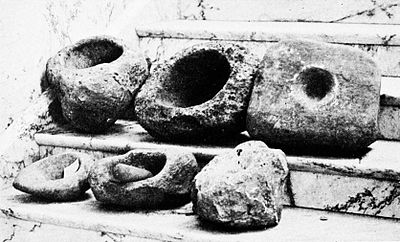utensils, the mill. In Fig. 5, i, the three pestles show a similar evolution, from the longish pebble to the right, to the purposely shaped large and symmetrical one to the left.
The absence among the stone implements of arrow and spear heads puzzled us greatly, since these objects are very generally

Fig. 4.
found up and down the coast. Only two decided flint arrow points were found in all our work, and these were two broken points of the black obsidian of Napa County, some distance north of the bay, evidently an imported product (Fig. 5, b). But on stating our difficulty to Mr. Horatio Rust, of Pasadena, who has made a lifelong study of archæology, especially in California, he informed us that the Indians of this part of the country used wooden points, hardened by fire, for their arrows and spears; these, of course, have perished, and certain it is that in all our valley we do not find these characteristic stone implements. We found, however, in the course of our excavation, many sharp-edged bits of rough flint which may have been used in very primitive work as knives or scrapers; and we did not fail to find those mysterious objects known as "charm stones," since Mr. Yates's careful study has revealed their nature. According to Mr. Yates, who relies on the testimony of old Indians, these stones were a part of the "medicine" of the California tribes, and used in various combinations to bring rain, success in hunting, or in war.[1] We found no other objects of superstition, unless the
- ↑ Charm Stones, the So-called "Plummets" or "Sinkers" of California. By Dr. Lorenzo Gordin Yates. Santa Barbara, California, 1890. Bulletin No. 2 of Santa Barbara Society of Natural History.
